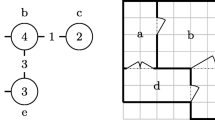Abstract
This paper provides solutions and insights into a new set of problems of catching a mobile robot intruder using limited information about the intruder’s location. The information about the intruder’s location, which is termed a snapshot, is only available upon request. We formulate the problem of tracking and catching an intruder with limited number of snapshots, which we termed the Moving Target Search with Snapshots (MTSWS). In the MTSWS problem a mobile guard \(G\) is chasing a mobile intruder \(B\) in \(R^{2}\). Here, \(G\) knows the location of \(B\) either from a requested snapshot or if \(G\) is sufficiently close to \(B\) by sensing it. Sensing is the ability of \(G\) to detect \(B\) directly (e.g., using a directional proximity sensor or a short range camera). The objectives are to determine the number of required snapshots in the worst case and to reduce the distance travelled by \(G\) as it attempts to catch \(B\) (i.e., getting close enough so that it can follow and catch \(B\) without additional information). In this paper we present (1) Solution for computing the number of snapshots that are necessary and sufficient to catch an intruder in the worst case. (2) Algorithmic solutions when \(G\) is limited to using k snapshots by determining the locations and the time that \(G\) should take the snapshots. (3) Algorithmic solution when taking a snapshot is associated with a time penalty. Namely, when \(G\) is taking a snapshot then \(G\) must wait for a period of time before it can move again. The time penalty is applied either before or after taking a snapshot.










Similar content being viewed by others
Data availability
There is no data inclusion for the paper.
References
Aigner, M., Fromme, M.: A game of cops and robbers. Discrete Appl. Math. 8(1), 1–12 (1984)
Alpern, S., Gal, S.: The Theory of Search Games and Rendezvous. Kluwer, New York (2003)
Björnsson, Y., Bulitko, V., Sturtevant, N.R.: Tba*: time-bounded a*. In: Boutilier, C. (ed.) Proceedings of the 21st International Joint Conference on Artificial Intelligence (IJCAI), Pasadena, California, USA, July 11–17, 2009, pp. 431–436 (2009)
Bulitko, V., Lee, G.: Learning in real-time search: a unifying framework. J. Artif. Intell. Res. 25, 119–157 (2006)
Chung, T.H., Hollinger, G.A., Isler, V.: Search and pursuit-evasion in mobile robotics—a survey. Auton. Robots 31(4), 299–316 (2011)
Dell, R.F., Eagle, J.N., Martins, G.H.A., Santos, A.G.: Using multiple searchers in constrained-path, moving-target search problems. Naval Res. Logist. 43, 463–480 (1996)
Dijkstra, E.W.: A note on two problems in connexion with graphs. Numer. Math. 1, 269–271 (1959)
Gal, S.: Search games with mobile and immobile hider. SIAM J. Control Optim. 17(1), 99–122 (1979)
Gal, S.: Search Games. ISSN. Academic Press, New York (1980)
Guibas, L.J., Latombe, J.-C., LaValle, S.M., Lin, D., Motwani, R.: Visibility-based pursuit-evasion in a polygonal environment. In: Dehne, F.K.H.A., Rau-Chaplin, A., Sack, J.R., Tamassia, R. (eds.) Algorithms and Data Structures, 5th International Workshop, WADS’97, August 6–8, 1997, Proceedings. Lecture Notes in Computer Science, vol. 1272, pp. 17–30. Springer, Halifax (1997)
Hart, P.E., Nilsson, N.J., Raphael, B.: A formal basis for the heuristic determination of minimum cost paths. IEEE Trans. Syst. Sci. Cybern. 4(2), 100–107 (1968)
Ishida, T., Korf, R.E.: Moving target search. In: Mylopoulos, J., Reiter, R. (eds.) Proceedings of the 12th International Joint Conference on Artificial Intelligence, August 24–30, 1991, pp. 204–211. Morgan Kaufmann, Sydney (1991)
Isler, V., Kannan, S., Khanna, S.: Randomized pursuit-evasion in a polygonal environment. IEEE Trans. Robot. 21(5), 875–884 (2005)
Koenig, S., Likhachev, M., Sun, X.: Speeding up moving-target search. In: Durfee, E.H., Yokoo, M., Huhns, M.N., Shehory, O. (eds.) 6th International Joint Conference on Autonomous Agents and Multiagent Systems (AAMAS 2007), May 14–18, 2007, pp. 1–8. IFAAMAS, Honolulu (2007)
LaValle, S.M., Lin, D., Guibas, L.J., Latombe, J.-C., Motwani, R.: Finding an unpredictable target in a workspace with obstacles. In: Proceedings of the 1997 IEEE International Conference on Robotics and Automation, April 20–25, 1997, pp. 737–742. IEEE, Albuquerque (1997)
Loh, P., Oh, S.: Cops and robbers on planar-directed graphs. J. Graph Theory 86(3), 329–340 (2017)
Nowakowski, R.J., Winkler, P.: Vertex-to-vertex pursuit in a graph. Discrete Math. 43(2–3), 235–239 (1983)
Nussbaum, D., Ilitchev, F.: Catching a robot intruder with limited information. In: Fourth IEEE International Conference on Robotic Computing (IRC2020), November 9–11, 2020, pp. 17–23 (2020)
Nussbaum, D., Yörükçü, A.: Moving target search with subgoal graphs. In: Brafman, R.I., Domshlak, C., Haslum, P., Zilberstein, S. (eds.) Proceedings of the Twenty-Fifth International Conference on Automated Planning and Scheduling, ICAPS 2015, Jerusalem, Israel, June 7–11, 2015, pp. 179–187. AAAI Press, Jerusalem (2015)
Sgall, J.: Solution of David Gale’s lion and man problem. Theor. Comput. Sci. 259(1–2), 663–670 (2001)
Sun, X., Yeoh, W., Koenig, S.: Moving target d* lite. In: van der Hoek, W., Kaminka, G.A., Lespérance, Y., Luck, M., Sen, S. (eds.) 9th International Conference on Autonomous Agents and Multiagent Systems (AAMAS 2010), Toronto, Canada, May 10–14, 2010, Vol. 1–3, pp. 67–74 (2010)
Author information
Authors and Affiliations
Corresponding author
Ethics declarations
Conflict of interest
The authors have no competing interests to declare that are relevant to the content of this article.
Additional information
Publisher's Note
Springer Nature remains neutral with regard to jurisdictional claims in published maps and institutional affiliations.
Rights and permissions
Springer Nature or its licensor (e.g. a society or other partner) holds exclusive rights to this article under a publishing agreement with the author(s) or other rightsholder(s); author self-archiving of the accepted manuscript version of this article is solely governed by the terms of such publishing agreement and applicable law.
About this article
Cite this article
Nussbaum, D., Ilitchev, F. Chasing an intruder with limited information. Int J Intell Robot Appl 7, 652–670 (2023). https://doi.org/10.1007/s41315-023-00286-y
Received:
Accepted:
Published:
Issue Date:
DOI: https://doi.org/10.1007/s41315-023-00286-y




